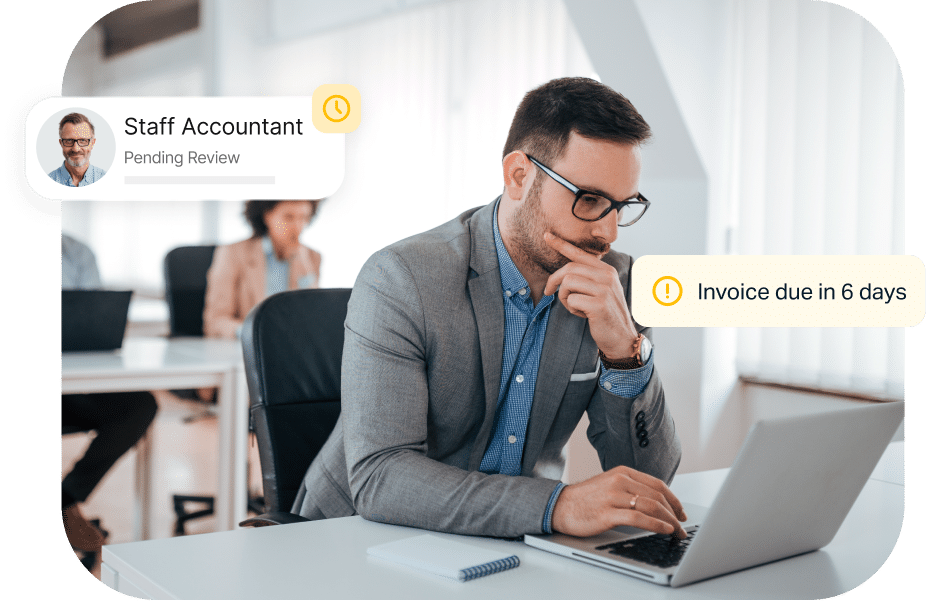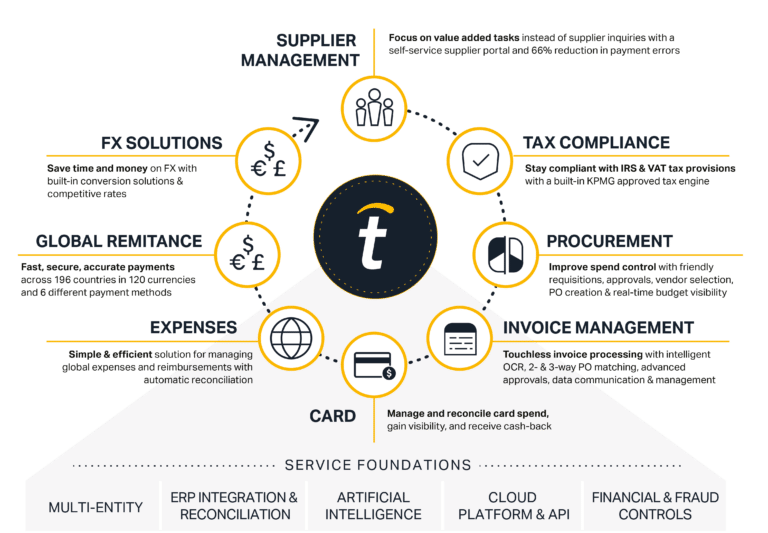The Total Guide to Acumatica ERP
Our guide covers everything you need to know about Acumatica ERP, including integration, market fit, pricing, features, and comparisons. Access our free e-book to learn more about automating accounts payable and global mass payments with Acumatica.
What is Acumatica ERP?
Acumatica ERP is a SaaS, modular, cloud-based software system that handles many business processes and functions throughout the company. Acumatica Cloud ERP solution offers industry-specific and company-size Editions (with some usage system constraints), including a General Business Edition. ERP is enterprise resource planning.
ERP software from Acumatica can be deployed either on the Public cloud with a SaaS subscription or Private cloud instead of on-premises. Private cloud licenses can either be subscription-based or perpetual.
Acumatica Cloud ERP industry-specific Editions are:
- Manufacturing
- Distribution
- Construction
- General Business
- Retail
- Professional Services
Functional area Acumatica modules Editions for the ERP and CRM are:
- Financial Management
- Project Accounting
- US Payroll
- Service Management
- Customer Management (CRM – customer relationship management)
Financial Management includes accounting software with financial reporting. Acumatica ERP has a software solution for time tracking and expense management that helps companies capture and control labor costs and bill for professional services and contract-allowable costs.
The Acumatica Service Management software module is for service companies, wholesale distributors, construction companies, and manufacturing companies with operations in the field needing a field service solution.
Acumatica company-size Editions are:
- Essentials
- 5-10 named users and under 20 employees, with 5 API connections included
- Select
- small business with 10-30 named users and 20-50 employees, with 5 API connections included
- Prime
- mid-market with 10-100 named users and 51-200 employees, with 10 API connections included
- Enterprise
- larger companies with 35- Unlimited named users and 200+ employees, with 10 API connections included
The linked Acumatica Licensing Guide lists Acumatica modules by Edition and company size and explains the licensing model.
Acumatica Cloud ERP software is accessed using mobile apps and computers.
Acumatica ERP users can use either a single tenant or operate multiple tenants. A single tenant is multi-entity and can contain an unlimited number of entities. Acumatica Select and Enterprise Edition customers can optionally get additional tenant license packs and specific elements to be shared by entities in different tenants.
Acumatica Cloud ERP is a business management solution that competes with NetSuite and is a step up in functionality from QuickBooks accounting software used by some small businesses.
Features
Key Features and Benefits of Acumatica
Acumatica provides the following features and benefits.
Ease of Use
The Acumatica ERP solution is user-friendly, with a flexible and intuitive user interface.
Personalization Features
Besides its customization tools for developers, Acumatica is an adaptable cloud ERP that offers low-code or no-code personalization without a programmer. Acumatica lets your business create customization packages using the Acumatica xRP platform to customize almost any screen with additional information or business logic.

Powered by Machine Learning and AI
Acumatica ERP has built-in machine learning and artificial intelligence that powers contextual help and many other valuable software features.

Real-time Dashboards
Acumatica provides real-time personalized dashboards that can add business intelligence like Microsoft Power BI.
Tailored Industry-Specific Editions
Industry-specific Editions of Acumatica ERP software incorporate industry best practices.
Wide Selection of Acumatica Modules
Users have an extensive selection of modules for a complete ERP experience

Accessible via Mobile App
Acumatica has a Mobile ERP app that uses iOS and Android mobile technology.

SaaS Subscription Pricing Based on Usage or Users
Businesses can pay by usage or transaction tiers with unlimited users or named user licensing for the number of users. Instead, Advanced and Enterprise customers can choose a licensing plan based on the number of concurrent users.
Acumatica personalization includes
- Modifying the order of tabs
- Specifying visibility of tabs and report lines,
- Defining valid values of fields
- Importing data
- Adding side panels
- Integrating third-party add-on apps and open API Acumatica modules
- Creating custom workflows using combo box values
- Building real-time dashboards using multiple data sources and add-on business intelligence software like Microsoft Power BI
- Selecting report definitions, KPIs, and charts that meet your business needs
The Acumatica module for Advanced Expense Management (AEM) lets employees submit expense receipts via mobile phone to automatically create expense receipts attached to bank feeds. The AEM functionality automatically creates expense receipts from credit card transactions and matches expenses to general ledger accounts. It flows expenses and expense receipts to project accounting.
Acumatica doesn’t issue corporate spending cards for your employees, but Advanced Expense Management works with other corporate credit cards that your company uses.
For procurement, Acumatica automates the purchase requisition process with Requisition Management software. The process includes order collection and requisition approval, supplier bids, sending and receiving quotes, issuing purchase orders, and receiving goods.
Acumatica needs third-party software as ERP app integrations to handle global mass payouts for creatives such as royalties, publishers, streamers, influencers, and other partners.
Industry-specific Editions of Acumatica ERP software incorporate industry best practices. Users have an extensive selection of modules for a complete ERP experience matching their business needs.
Modules
Acumatica Modules
The Acumatica Licensing Guide (see above) includes a list of Acumatica modules available for each Industry Edition. When businesses don’t operate in one of the named industry editions, they can use the General Business Edition. This list of modules shows included base system modules and optional modules to fill specific business needs with the General Business Edition, Enterprise plan.

Financials
Financials is a base system module included in the General Business Edition for general ledger, accounts receivable, accounts payable, and financial statements.
Global Financials and Intercompany Accounting
Global Financials is an optional Acumatica module, with multi-entity and multi-currency, to create consolidated reports and drill-down to transactions details.
The optional Intercompany Accounting module in Acumatica handles the elimination of intercompany transactions and intercompany reconciliations. It also works for intercompany allocations of shared expenses and asset transfers between entities.


Deferred Revenue
Acumatica has an optional Deferred Revenue module for compliance with GAAP ASC 606 and IFRS 15 accounting compliance. Companies can create customized deferral schedules and use multiple revenue recognition methods.
Ready to optimize Acumatica with Tipalti AP automation?
Acumatica plays a key role in finance, but AP often requires specialized solutions. Discover how executives are enhancing their ERP and AP integration with automation.
Industries
Industries Using Acumatica
Acumatica customers are small businesses and mid-market companies (SMBs), although Acumatica sells its “Enterprise” version to companies with more than 200 employees. Customers are located in the United States and international locations.
Manufacturing companies like Acumatica manufacturing modules for:
- Manufacturing bill of materials (BOM) and production management,
- Material requirements planning (MRP) for Advanced and Enterprise users and
- Optional Acumatica modules for manufacturers:
- Product Configurator
- Estimating
- Planning and Scheduling
- Engineering Change Control
- Manufacturing Data Collection
Companies with inventory like supply chain, inventory management (to track inventory and cost by item), warehouse management, and distribution management features in the Acumatica software solution. Companies with inventory can purchase the Order Management and Inventory Management modules instead of the Distribution Edition. Order Management with Inventory Management includes Sales Order Management, Purchase Order Management, and Requisition Management.
Companies that don’t have inventory, like service companies, can purchase the Acumatica Order Management to create sales quotes, sales orders, and purchase orders.
Construction companies like the inclusion of project management and project accounting in the Acumatica Construction Edition. (Project accounting is also available as a module for other versions).

Advertising Technology, Digital Media

Agriculture and Farming

Construction, Manufacturing

Distribution, Retail and eCommerce

Education

Financial Services

Food and Beverage

Healthcare

Non-Profit

Services

Software and Technology

Telecommunication

Travel and hospitality
Implementation
How to Implement and Use Acumatica
Acumatica training is free at Acumatica Open University. The Acumatica University course catalog includes Getting Started with Acumatica ERP and implementation courses for Acumatica software modules. Acumatica customer support offers resources, Fast Track Deployment, and an upgrade to Premier Customer Direct Support. An Acumatica partner sells software and provides consulting services.

Step 1
Communication
The CEO or responsible top executive should communicate the importance of the Acumatica implementation project to the entire organization.
Step 2
Implementation Team
To begin implementation, select a multi-functional team with a designated leader that includes employees and an Acumatica partner consultant.

Step 3
Implementation Consultant
The consultant should provide proven implementation models for the company to customize.

Step 4
Project Planning
The implementation team should establish implementation goals and milestones with assigned task responsibilities and deadlines. These milestones will include data migration and testing the software before going live.

Step 5
Training
First, train the implementation team to use Acumatica software. Designated team members can train other employee users for their role-related use of Acumatica.
Step 6
Post-Implementation Evalution
In a report, document successes of this implementation and areas for improvement for future software implementation projects.
How Does AP Automation Software Integration Work With Acumatica?
Acumatica integrations with third-party SaaS add-ons are through a flat-file or API software connection. The Tipalti AP automation software uses flat-file integration, which automates global mass payments using large data files related to payables well. ERP system users access Tipalti features through the Acumatica login and user interface.
Tipalti AP automation software includes these features:
- Self-service supplier onboarding with W-9 or W-8 form collection and automated supplier validation
- Tax compliance simplicity
- Invoice processing starting with digital capture using OCR and AI technology
- Application of 26,000+ global payment rules
- Automated 3-way or 2-way matching
- Automated global regulatory compliance, including OFAC sanctions list screening
- Approval routing and communications
- Global payments as efficient large batches to 196 countries in 120 currencies with a choice of electronic payment methods
- Data syncing with Acumatica
- Real-time automated payment reconciliation to the GL
- Multi-entity
- Real-time spend visibility and an AI digital assistant to aid decision-making and better control costs

Tipalti offers other finance automation software products in its unified platform, including advanced FX solutions, employee expense reimbursement software, mass payments, and procurement software. The Tipalti Expenses and Multi-FX work with the AP automation software. All Tipalti products integrate with Acumatica ERP and other ERPs or accounting software.
Tipalti mass payments software efficiently makes large batch payouts to affiliates, publishers, ad networks, creatives, influencers, streamers, and independent contractors like freelancers. The Tipalti mass payments software also integrates with performance marketing system platforms that calculate the amounts due to the payees.
Tipalti offers approved users a corporate spending card with rewards called the Tipalti Card. The corporate card helps companies control each card-assigned employee’s non-PO business spend.
Tipalti’s cloud AP automation software is scalable for growth and helps you reduce hiring as volume increases. Tipalti software eliminates manual processes and paper through digitization and reduces end-to-end payables time by 80%. It reduces errors by 66% and can speed your monthly close by 25%. You’ll complete invoice processing on time to take early payment discounts from suppliers, significantly reducing your purchase costs for inventory and expenses.
How Much Does Acumatica Cost?
Acumatica ERP cost includes:
- Acumatica cloud ERP pricing for selected Acumatica modules
- Computing resource usage or number of users
- Implementation and customization consulting costs
- Third-party add-on software
- Optional upgrades, like premier Customer Direct Support or Fast Track Implementation
Request a quote for Acumatica Cloud ERP software and services from your local value-added reseller (VAR) in the Acumatica partner program.
Recommendations